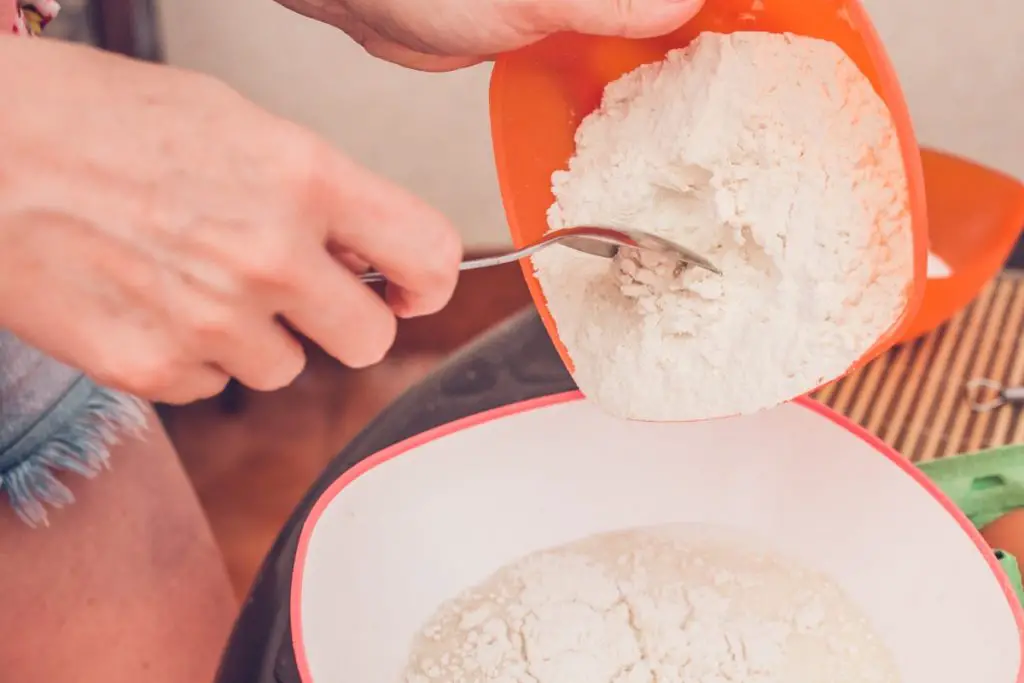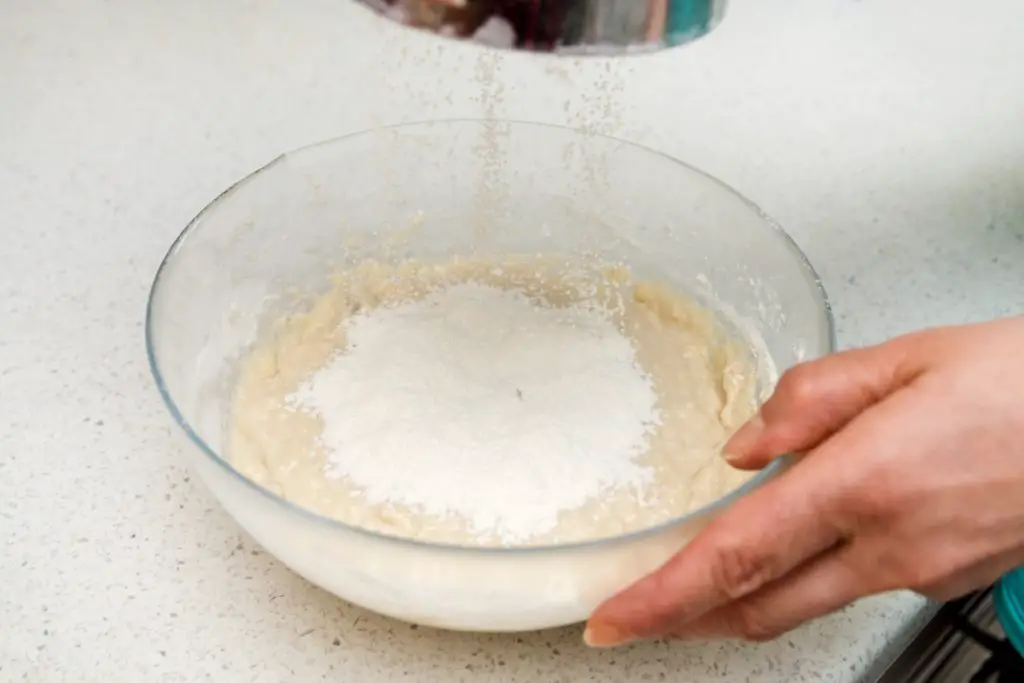All bread recipes call for dough. The main ingredient of dough is flour. But do you know what happens if you add too much flour to the dough? Read more here to find out how to solve one of the most common issues with dough, adding too much flour.
Adding too much flour to the dough mixture will result in a dry and unyielding dough. Too much flour in the dough is an easy mistake. This error can be fixed by adding more liquid. Alternatively, adding more fat to your recipe and mixing the dough with your hands can help to lubricate dry dough.
There are many different types of dough. A common mistake anyone can make when baking is; too much flour in your dough. That happens to dough with too much flour and, more specifically, bread dough with too much flour. Here is some advice on how to fix dough with too much flour.
What Happens If You Add Too Much Flour To Dough

Adding too much flour into your mixture will result in a very dry and extremely stiff dough. The dough will be too tight and tough to stretch when you attempt to pull it or roll it out. Overfloured dough could become crumbly and break and fall apart during the kneading process.
It is also possible that the raising agent for this dough isn’t sufficiently activated. Raising agents like bicarb and baking powder need moisture to be activated. Not correctly starting these ingredients will result in an unleavened or flattened baked good.
Too much flour in the dough will interfere with the way that the other elements interact. Sugar, salt, and fat all play an essential part in making good dough. Having too much flour in your dough, you spread the other elements too thinly, resulting in an unpalatable baked good.
If there is too much flour added to the dough, the structure of the dough is compromised. A high flour content dough is a “strong” dough. If the strength of the dough is too high, the gluten proteins and starch molecules take the strain, and the dough will not rise.
What Happens If You Put Too Much Flour To Bread Dough
Too much flour in bread dough will result in a dry dough that is hard to knead. It will be crumbly and unpleasant.
If your dough is too dry, there won’t be enough moisture available to feed the yeast. The raising agent yeast is what creates the pillowy effect in bread. By releasing carbon dioxide, the yeast expands the gluten proteins that keep the starch in place.
Moisture and manipulation are what activate the gluten proteins that make bread dough pliable. An under-activated gluten structure will result in a dense unrelenting dough.
If you were to proceed ahead and bake such a dry loaf, you would get a dry, dense, heavy loaf of bread. The bread will most likely be unpalatable and inedible.
TIP: Not sure if you have all the necessary bread baking equipment at home? Check out my recommended picks below (Amazon links):
-
- Scale: Nicewell 22lb Digital Kitchen Scale
- Mixing Bowls: OXO Stainless Mixing Bowls Set
- Pastry Scraper: OXO Stainless Pastry Scraper
- Loaf Pan: OXO Non-stick Loaf Pan
- Kitchen Thermometer: ThermoPro Digital Thermometer
- Stand Mixer (optional): Kenwood Kmix Stand Mixer
TIP: Do you know what to do if you add too much yeast to in bread dough? Check out this article:
Too Much Yeast In Dough: What Happens And How To Fix It
How To Fix Dough With Too Much Flour

The best way to fix dough that has too much flour and is too dry is to simply add more liquid or fat to the mixture and knead. Adding water, milk, eggs, or fat to the dough is important to rehydrate and activate the yeast and is responsible for the consistency of the dough.
Add the extra liquid one teaspoon at a time, mixing thoroughly between spoons. Milk, water, or eggs are suitable.
Adding the liquid teaspoon per teaspoon will make it easier to mix thoroughly and prevent lumps. Staggering the addition of liquid in this way will also prevent unintentionally adding too much liquid.
Adding more fat to your dough can help. Many types of fat are used in baking. Butter, vegetable oil, and shortening are all suitable fats.
You can also use eggs to moisten your dough. They contain both liquid and fat and will lend richness to your baking. Add the fat in a staggered manner, one teaspoon at a time to prevent adding too much fat.
Use your hands to mix or knead the dough. If you have tried adding fat and liquid yet still have a stiff dough, try mixing it with your hand.
This method can be a bit messy but worth it. Automatic mixers can let you down. In this eventuality, reverting to manual mixing or kneading can help salvage a dry dough.
The heat generated by your hands will help to lubricate your dough by activating the gluten proteins and starch molecules. Getting acquainted with your dough intimately will help you to find and disperse any lumps or inconsistencies.
How To Fix Too Much Flour In Bread Dough
The most straightforward answer is sometimes the best. The best way to fix bread dough with too much flour is to add more liquid.
This seems obvious but proceed with caution as there is still some room for error. It is advisable to add water for bread dough if it has too much flour, though some recipes allow for milk, like Japanese Milk Bread (Hokkaido).
Take care not to make your recipe too big accidentally. It is wasteful, and too much liquid will strain the yeast in your dough and result in unleavened bread.
To fix bread dough with too much flour in, add your chosen liquid one teaspoon at a time. It will ensure that the liquid is mixed thoroughly and prevent lumps from forming.
Before adding more liquid to your bread dough, discard 8% to 12% of your over-floured dough. This step will keep the size of your loaf regulated.
Some bread recipes call for butter or oil; in this case, adding a little extra fat will help moisten your bread dough. The fat should be added one drop at a time, as adding too much fat will flatten your loaf while baking.
Only add warm liquids to dry ingredients when using a yeast bread recipe. If the liquid is too hot, it will destroy the yeast and prevent it from rising, whereas if it is too cold, the yeast action will slow down or stop.
TIP: If you are looking for the best flour for your bread I recommend using flour produced by companies mentioned below (Amazon links):
Conclusion
Now that we know what happens when you add too much flour to your dough, we need to understand how to fix this common mistake.
With these valuable insights and quick problem-solving solutions at hand, baking will be a hobby to approach with confidence.
Let’s wash our hands, put on our aprons, and bake something delicious. From the humble daily loaf to the highest tier of patisserie; everyone enjoys freshly baked goods.
TIP: If you are still not sure how much, when and why to add flour in bread dough, check out the article below:
